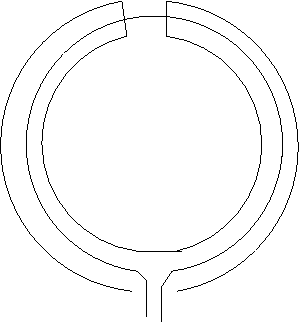Shielded Loop Antenna / Yagi-Uda array of loops
It is plenty of article on home builds antenna onto the internet. Most of them are for antenna that can work for both emission and reception.
We will see here two different designs for reception into the FM and TV band. Those 2 designs are using the same base type of antenna: the loop antenna.
Shielded loop
A crude representation of a shielded loop:

The principle is the same than for a loop. From wikipedia: a continuous conducting path leading from one conductor of a two-wire transmission line to the other conductor. All planar loops are directional antennas with a sharp null, and have a radiation pattern similar to the dipole antenna with E and H fields interchanged.
The main advantages of loops antenna are tree:
1) An outstanding signal quality. It is a simple design that perform very well.
2) For large loops, higher gain (about 10%) than the other forms.
3) Large loop antennas are less susceptible to localized noise, partly due to their lack of a need for a groundplane.
The advantage of a shielded loop over a non shielded one:
4) The electric interference from the big city (streetlights, television's , cars etc...) have no influence on the received signal.
Practical realization
Like we will not perform emission, any good quality coaxial cable may be used to realize such an antenna. Critical to correctly design this antenna is the wavelength of the program you want to receive best.
Less critical but important is the capacitance of the coaxial cable. The circumference of the loop will be equal to the wavelenght, and that capacitance is not negligible. In practice, any good coaxial cable for TV installation will do the job.
My first concern with this antenna was the FM band, because I was completely unable to receive my favorite radio program on 93.8 MHz where I am living.
Wavelength [meter] = 300 / frequency [MMHz]
For 93.8 MHz, we have 300 / 93.8 = 3.198 meters.
According to the Balanis (Antenna Theory: Analysis and Design, by Constantine A. Balanis, it is better to use a little bigger circle. (Read the book for the details.)
Antenna circumference = 1.1 * wavelength = 1.1 * 3.198 = 3.518 meters.
So, we need 3.52 meters of coaxial cable.
For the realization, it is up to you. Metal will not work because it will interfere with the antenna. Plastic or wood are best. The best design is one that will approach a perfect circle, like a bicycle wheel.
I made mine with one vertical stick of wood and 6 smaller sticks of the same wood. I made small holes at the extremity of each stick in order to be able to attach the coaxial there. I used 2 more little pieces of wood at the center of this wheel in order to fix the sticks.